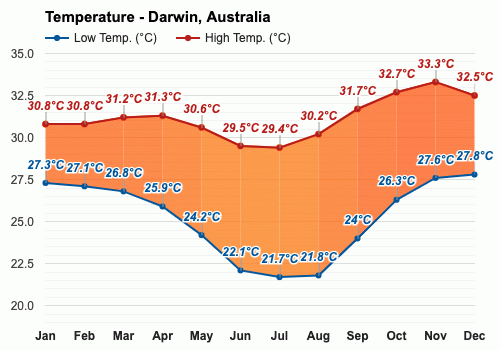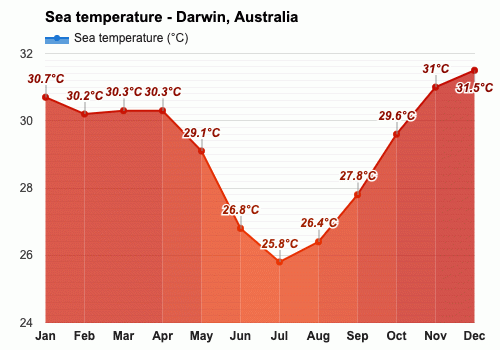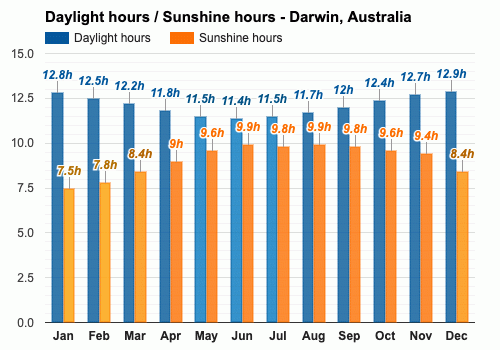Contents
- Weather in February
- Frequently asked questions
- Average temperature in February
- Average pressure in February
- Average wind speed in February
- Average humidity in February
- Average rainfall in February
- Average rainfall days in February
- Average sea temperature in February
- Average daylight in February
- Average sunshine in February
- Average sunshine days in February
- Average UV index in February
- Average cloud cover in February
- Average visibility in February
Weather in February
Temperature
Darwin, Australia, logs a shift to a still hot 30.8°C (87.4°F) as the average high temperature in February, the same as January. Darwin's average low temperature, barely cooler than the daytime high, steadies at a warm 27.1°C (80.8°F) during February.Heat index
February's heat index is appraised at a scorching 40°C (104°F). Special measures are necessary to avoid heat cramps and heat exhaustion. Persistent activity could result in heatstroke.Evaluating the heat index requires understanding its values in the shade and with gentle winds. The heat index might be elevated by 15 Fahrenheit (8 Celsius) degrees due to direct sun exposure.
Note: The heat index, also known as 'felt air temperature' or 'real feel', is an aggregate value of air's warmth and moisture to show the human-felt temperature. The influence of weather is personal, differing among individuals based on variations in body mass, stature, and the degree of physical exertion. Do note, being directly under sun rays can amplify the heat you feel, potentially raising the heat index by 15 Fahrenheit (8 Celsius) degrees. Heat index values remain especially vital for babies and toddlers. In general, children are more at risk than adults because they sweat less. Furthermore, the large skin surface compared to their small bodies and the high heat production due to their actions contribute to this vulnerability.
Perspiration is the body's default response to elevated temperatures, as it promotes the evaporation of sweat to achieve cooling. An increase in relative humidity retards evaporation, subsequently reducing the body's heat removal rate and leading to a sensation of being overly warm. Accumulating heat beyond the body's cooling measures leads to rising temperatures and potential ailments.
Humidity
The months with the highest humidity in Darwin, Australia, are January and February, with an average relative humidity of 78%.Rainfall
In February, the rain falls for 25.8 days. Throughout February, 225mm (8.86") of precipitation is accumulated. In Darwin, during the entire year, the rain falls for 191.8 days and collects up to 1282mm (50.47") of precipitation.Sea temperature
In February, the average sea temperature is 30.2°C (86.4°F).Note: When the water's temperature hits more than 30°C (86°F), it arguably becomes less enjoyable for cooling down.
Daylight
In Darwin, the average length of the day in February is 12h and 30min.On the first day of the month, sunrise is at 6:40 am and sunset at 7:19 pm. On the last day of February, in Darwin, sunrise is at 6:48 am and sunset at 7:09 pm ACST.
Sunshine
In February, the average sunshine in Darwin is 7.8h.UV index
January through October and December, with an average maximum UV index of 7, are months with the lowest UV index. A UV Index value of 6 to 7 symbolizes a high health hazard from unsafe exposure to UV radiation for ordinary individuals.Note: The maximum UV index of 7 during February translates into these guidelines:
Escape overexposure. People with light skin may incur burns in fewer than 20 minutes. Remember that UV radiation from the Sun is strongest between 10 a.m. and 4 p.m. Make an effort to limit direct sun exposure during this time. In the presence of strong sunlight, it's crucial to wear sunglasses that ward off UVA and UVB rays. Caution! The reflection of sand and water significantly increases the intensity of the Sun's UV radiation.
Published by: Weather Atlas | About Us
Data Sources | Weather Forecasting & Climate
Frequently asked questions
How hot is February in Darwin?
What are the most humid months in Darwin?
What is the average humidity in February in Darwin?
How much does it rain in Darwin in February?
How warm is the water in February in Darwin?
What is the average length of the day in February in Darwin?
When are sunrise and sunset in February in Darwin?
How long on average sun shines in February in Darwin?
When is the lowest UV index in Darwin?
What is the UV index intensity in February in Darwin?
Average temperature in February
Darwin, Australia

- Average high temperature in February: 30.8°C
The warmest month (with the highest average high temperature) is November (33.3°C).
The month with the lowest average high temperature is July (29.4°C).
- Average low temperature in February: 27.1°C
The month with the highest average low temperature is December (27.8°C).
The coldest month (with the lowest average low temperature) is July (21.7°C).
Average pressure in February
Darwin, Australia

- Average pressure in February: 1007.2mbar
The months with the highest atmospheric pressure are July and August (1013.2mbar).
The month with the lowest atmospheric pressure is January (1006.3mbar).
Average wind speed in February
Darwin, Australia

- Average wind speed in February: 14.2km/h
The windiest month (with the highest average wind speed) is January (15.3km/h).
The calmest month (with the lowest average wind speed) is September (9.9km/h).
Average humidity in February
Darwin, Australia

- Average humidity in February: 78%
The months with the highest relative humidity are January and February (78%).
The month with the lowest relative humidity is June (57%).
Average rainfall in February
Darwin, Australia

- Average rainfall in February: 225mm
The wettest month (with the highest rainfall) is January (340mm).
The driest months (with the least rainfall) are June, July and August (2mm).
Average rainfall days in February
Darwin, Australia

- Average rainfall days in February: 25.8 days
The month with the highest number of rainy days is January (28.3 days).
The month with the least rainy days is June (1.9 days).
Average sea temperature in February
Darwin, Australia

- Average sea temperature in February: 30.2°C
The best month for swimming (with the highest average sea temperature) is December (31.5°C).
The coldest month (with the lowest average sea temperature) is July (25.8°C).
Average daylight in February /
Average sunshine in February
Darwin, Australia

- Average daylight in February: 12h and 3min
The month with the longest days is December (Average daylight: 12h and 48min).
The month with the shortest days is June (Average daylight: 11h and 24min).
- Average sunshine in February: 7h and 5min
The months with the most sunshine are June and August (Average sunshine: 9h and 54min).
The month with the least sunshine is January (Average sunshine: 7h and 30min).
Average sunshine days in February
Darwin, Australia

- Average sunshine days in February: 0.9 days
The month with the most sunshine days is July (28.4 days).
The month with the least sunshine days is February (0.9 days).
Average UV index in February
Darwin, Australia

- Average UV index in February: 7
The month with the highest UV index is November (UV index 8).
The months with the lowest UV index are January, February, March, April, May, June, July, August, September, October and December (UV index 7).
Average cloud cover in February
Darwin, Australia

- Average cloud cover in February: 42
The month with the most cloud cover is January (Cloud cover 47).
The month with the least cloud cover is August (Cloud cover 9).
Average visibility in February
Darwin, Australia

- Average visibility in February: 9km
The months with the highest visibility are April, May, June, July, August, September, October and November (10km).
The months with the lowest visibility are January, February, March and December (9km).
Darwin, Australia
Weather forecast for your location
2. Allow the app to use your location


